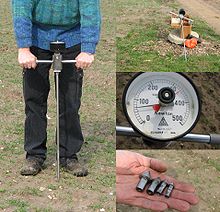Penetrometer
A penetrometer is used in agriculture, in horticulture and landscaping, in sports and golf course maintenance, for soil and foundation surveys (determination of bearing capacity) and for determining the needle penetration of bitumen and bituminous binders (DIN EN 1426:2007-06) and is a measuring device for determining the penetration resistance of one body into another. The term consists of the Latin root penetrare (= to penetrate) and metiri (to measure). The result is measured in kilograms (kg), Newtons (N), pounds (Lb) or US ounces (oz). In conjunction with the area of the penetration tip (mandrel) used, this results in a value for the pressure in N per cm² at which the tested surface or layer yields.
There are analogue and digital penetrometers, handheld devices as well as automatic resistance meters.
Fruit penetrometers are used in agriculture to determine the firmness of fruit. Firmness, starch and sugar are used to determine the ripeness index.
Soil penetrometers are also used to determine the resistance to penetration, and thus the density, of a soil (again, a measure of bearing capacity and rootability). The reading is in psi (pound-force per square inch). Penetrometers are also used in connection with soil and building material testing. They are also used as penetrometers. In the Federal Republic of Germany, DIN 4094, among others, regulates the use of penetrometers for soil probing (pressure probing, etc.).
In space exploration, automatic space probes (so-called penetrators) are used that have penetrometers or are themselves a remote-controlled penetrometer. In 1973, the Soviet Lunochod 2 lunar vehicle also had a penetrometer at the end of the vehicle, designed as an automatic drill-like device with a cone-shaped punching tool as the central part. At the lower end of the cone, four paddle blades were arranged in a cross shape. From time to time, a special mechanism pressed the penetrometer into the regolith of the lunar surface and then slowly rotated it about its longitudinal axis. The resistance created during the pressing in and rotation was constantly measured and radioed to Earth. From this measurement data, it was possible to determine the mechanical properties of the regolith fairly accurately: Density, strength, consistency, load-bearing capacity, etc. This, in turn, provides information about how the soil was formed and its geological evolution.
In pharmaceutical technology, a penetrometer is used to characterize the consistency of semi-solid substances and preparations (e.g. creams, ointments, or cream or ointment bases). The test is described in the European Pharmacopoeia: the penetrometer consists of a measuring device and a cone-shaped test body with specified dimensions. The latter is applied with its tip to the sample placed in a container under defined conditions and the penetration depth is measured after 5 seconds with the measuring device of the penetrometer. It is a measure of the consistency, i.e. "softness" of the product.

Penetrometer
Search within the encyclopedia